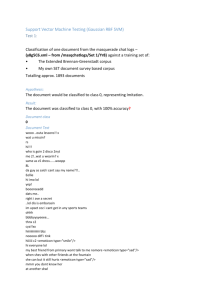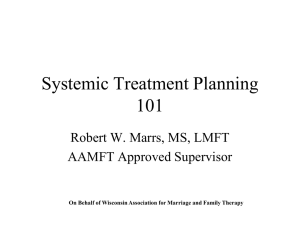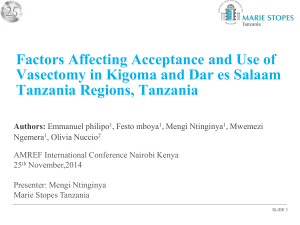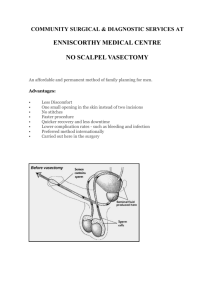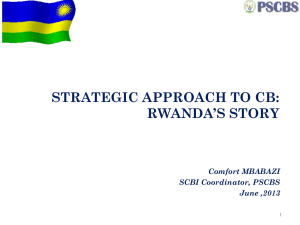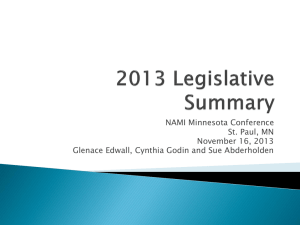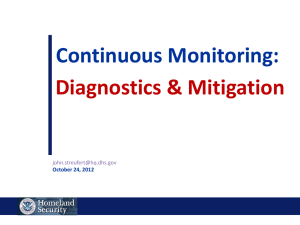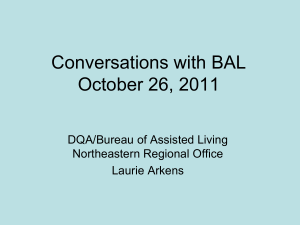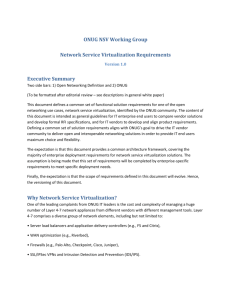View presentation - The Bixby Center on Population and
advertisement
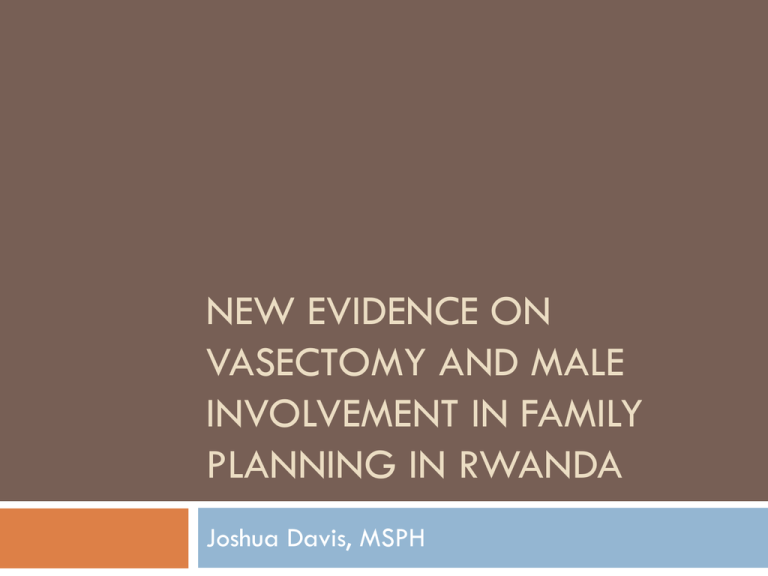
NEW EVIDENCE ON VASECTOMY AND MALE INVOLVEMENT IN FAMILY PLANNING IN RWANDA Joshua Davis, MSPH Overview Context and program background Data and Methods Research objective Methods Results Conclusions Background – Rwanda Population: 10,473,282 th Pop. Growth: 2.7 (17 Worldwide) TFR: 5.5 children/woman (22nd worldwide) Most densely populated country in Africa (similar in density to Netherlands) • • 48% of women want no more children 38% of women have unmet need for FP (want to limit or space births but weren’t using contraception) Government of Rwanda has made family planning a national priority Background – No-scalpel vasectomy Safe, effective, underused Percentage of women of reproductive age who rely on vasectomy for contraception Worldwide 2.7% Africa Asia 0.0% 3% Latin America/Caribbean 1.3% Europe 2.9% North America 10.3% Oceania 7.4% Background – IntraHealth’s Pilot Program Funding from USAID’s Office of Population NSV initially introduced in two districts Created supply of trained providers Generated demand for services in population Introduced data collection system for clients Data – Program Evaluation Conducted in Summer of 2009 Goal was to evaluate aspects of the pilot program that were successful and develop recommendations for a countrywide scale up Data – NSV client records Parallel to standard HMIS to gather additional information on male acceptors Additional questions were integrated into the patient screening form: Demographic information on clients Qualitative responses on use and attitudes towards family planning Service outcomes and statistics Objective To assess the profile of vasectomy acceptors and to identify key aspects of the program that led to relatively high uptake rates compared to similar efforts in Sub-Saharan Africa Methods – Program Evaluation IntraHealth M&E staff conducted evaluation in Summer 2009 Focus groups and individual interviews with 50 stakeholders Process evaluation of pilot implementation Methods – Records Review IntraHealth staff visited 10 sites where NSVs were preformed by project-trained staff Records were entered into a database Qualitative responses were categorized by in country staff Results Socio-demographic characteristic of the males in the Rwandan NSV pilot program Mean n Std. Dev. Client's Age 44.8 450 9.6 Spouse's Age 38.3 440 7.4 Number of Children 5.7 453 2.1 Number of Sons 2.9 453 1.5 Number of Daughters 2.8 453 1.6 % n Education Level None 25.8% 113 Primary 63.5% 278 Secondary 10.7% 47 Occupation Farmer 91.3% 411 Unemployed 0.2% 1 Skilled Manual 2.7% 12 Prof., Tech., Manag. 3.3% 15 Sales, Services 2.0% 9 Unskilled manual 0.4% 2 HIV Status No Answer 62.3% 286 Negative 26.8% 123 Positive 10.9% 50 Min. 24 24 0 0 0 Max. 85 65 14 7 9 NSV clients compared to DHS sample NSV clients under 25 - 59 compared to DHS married sample NSV Clients 25 -59 DHS married n Mean n Mean Age 412 43.2 1583 39.9 Number of Children 412 5.6 1583 4.5 n % n % Education Level None 95 23.9% 339 20.7% Primary 256 64.3% 1002 63.3% Secondary 47 11.8% 252 15.9% Occupation Farmer 371 90.5% 650 41.1% Prof., Tech., Manag. 15 3.6% 116 7.3% Skilled Manual 12 2.9% 127 8.0% Sales 9 2.2% 56 3.5% Unskilled manual 2 0.5% 73 4.6% Not working 1 0.2% 555 35.1% Other 0 6 0.4% NSV clients compared to sample Mean children by age of client, NSV and DHS 10 9 Children (mean) 8 7 6 5 DHS 4 NSV 3 2 1 0 25 30 35 40 45 Age 50 55 60 Reason for wishing to cease having children 70% 60% 60% 50% 40% 30% Enough children Financial concerns 32% Health Other 20% 10% 8% 0% n = 455 1% Reasons for choosing vasectomy 50% Concern about wife's health 45% 40% 43% Convienence/ease/eff ectiveness of NSV 35% 30% Enough children 25% 25% 20% Financial concerns 15% 10% 5% 0% 12% 10% 5% 4% n =448 Side effects of other methods Other Rumors heard about FP and vasectomy 30% 25% 26% 26% 20% Castration 20% Decreased libido 15% 15% 13% 10% Impotence None Other 5% 0% n =196 Previous contraceptive use 45% 40% 40% 35% 30% Injectables 25% Pill 20% Condom 21% None 15% 15% Other 14% 10% 10% 5% 0% n = 461 Results – Program evaluation • Sustainable Approach • • • Community Health Worker outreach • • 252 men (54%) reported speaking to a CHW before deciding to have a NSV Service Extension Model • • 10 doctors and 25 nurses trained in NSV Service expanded to 8 other (10 total) districts 59% of NSVs were done as part of extension service Engagement of Political Stakeholders Conclusions Given access and information, men in Rwanda are willing to accept sterilization as a from of family planning Supply creation and demand generation need to be coordinated IEC materials can be delivered at a community level in the absence of a mass media strategy Thank you
